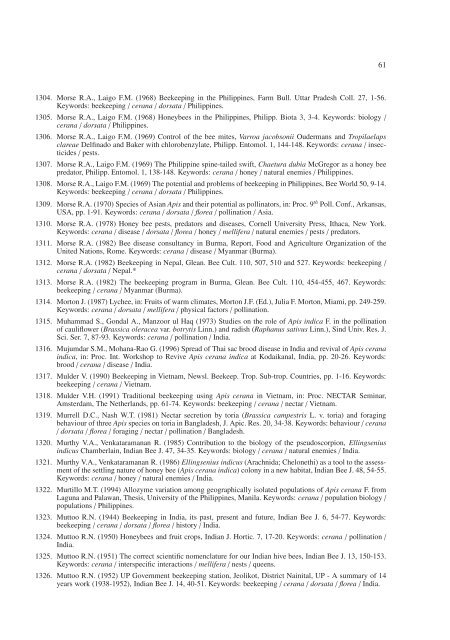Bibliography of Apis cerana Fabricius - Apidologie
Bibliography of Apis cerana Fabricius - Apidologie
Bibliography of Apis cerana Fabricius - Apidologie
Create successful ePaper yourself
Turn your PDF publications into a flip-book with our unique Google optimized e-Paper software.
1304. Morse R.A., Laigo F.M. (1968) Beekeeping in the Philippines, Farm Bull. Uttar Pradesh Coll. 27, 1-56.<br />
Keywords: beekeeping / <strong>cerana</strong> / dorsata / Philippines.<br />
1305. Morse R.A., Laigo F.M. (1968) Honeybees in the Philippines, Philipp. Biota 3, 3-4. Keywords: biology /<br />
<strong>cerana</strong> / dorsata / Philippines.<br />
1306. Morse R.A., Laigo F.M. (1969) Control <strong>of</strong> the bee mites, Varroa jacobsonii Oudermans and Tropilaelaps<br />
clareae Delfinado and Baker with chlorobenzylate, Philipp. Entomol. 1, 144-148. Keywords: <strong>cerana</strong> / insecticides<br />
/ pests.<br />
1307. Morse R.A., Laigo F.M. (1969) The Philippine spine-tailed swift, Chaetura dubia McGregor as a honey bee<br />
predator, Philipp. Entomol. 1, 138-148. Keywords: <strong>cerana</strong> / honey / natural enemies / Philippines.<br />
1308. Morse R.A., Laigo F.M. (1969) The potential and problems <strong>of</strong> beekeeping in Philippines, Bee World 50, 9-14.<br />
Keywords: beekeeping / <strong>cerana</strong> / dorsata / Philippines.<br />
1309. Morse R.A. (1970) Species <strong>of</strong> Asian <strong>Apis</strong> and their potential as pollinators, in: Proc. 9th Poll. Conf., Arkansas,<br />
USA, pp. 1-91. Keywords: <strong>cerana</strong> / dorsata / florea / pollination / Asia.<br />
1310. Morse R.A. (1978) Honey bee pests, predators and diseases, Cornell University Press, Ithaca, New York.<br />
Keywords: <strong>cerana</strong> / disease / dorsata / florea / honey / mellifera / natural enemies / pests / predators.<br />
1311. Morse R.A. (1982) Bee disease consultancy in Burma, Report, Food and Agriculture Organization <strong>of</strong> the<br />
United Nations, Rome. Keywords: <strong>cerana</strong> / disease / Myanmar (Burma).<br />
1312. Morse R.A. (1982) Beekeeping in Nepal, Glean. Bee Cult. 110, 507, 510 and 527. Keywords: beekeeping /<br />
<strong>cerana</strong> / dorsata / Nepal.*<br />
1313. Morse R.A. (1982) The beekeeping program in Burma, Glean. Bee Cult. 110, 454-455, 467. Keywords:<br />
beekeeping / <strong>cerana</strong> / Myanmar (Burma).<br />
1314. Morton J. (1987) Lychee, in: Fruits <strong>of</strong> warm climates, Morton J.F. (Ed.), Julia F. Morton, Miami, pp. 249-259.<br />
Keywords: <strong>cerana</strong> / dorsata / mellifera / physical factors / pollination.<br />
1315. Muhammad S., Gondal A., Manzoor ul Haq (1973) Studies on the role <strong>of</strong> <strong>Apis</strong> indica F. in the pollination<br />
<strong>of</strong> cauliflower (Brassica oleracea var. botrytis Linn.) and radish (Raphanus sativus Linn.), Sind Univ. Res. J.<br />
Sci. Ser. 7, 87-93. Keywords: <strong>cerana</strong> / pollination / India.<br />
1316. Mujumdar S.M., Mohana-Rao G. (1996) Spread <strong>of</strong> Thai sac brood disease in India and revival <strong>of</strong> <strong>Apis</strong> <strong>cerana</strong><br />
indica, in: Proc. Int. Workshop to Revive <strong>Apis</strong> <strong>cerana</strong> indica at Kodaikanal, India, pp. 20-26. Keywords:<br />
brood / <strong>cerana</strong> / disease / India.<br />
1317. Mulder V. (1990) Beekeeping in Vietnam, Newsl. Beekeep. Trop. Sub-trop. Countries, pp. 1-16. Keywords:<br />
beekeeping / <strong>cerana</strong> / Vietnam.<br />
1318. Mulder V.H. (1991) Traditional beekeeping using <strong>Apis</strong> <strong>cerana</strong> in Vietnam, in: Proc. NECTAR Seminar,<br />
Amsterdam, The Netherlands, pp. 61-74. Keywords: beekeeping / <strong>cerana</strong> / nectar / Vietnam.<br />
1319. Murrell D.C., Nash W.T. (1981) Nectar secretion by toria (Brassica campestris L. v. toria) and foraging<br />
behaviour <strong>of</strong> three <strong>Apis</strong> species on toria in Bangladesh, J. Apic. Res. 20, 34-38. Keywords: behaviour / <strong>cerana</strong><br />
/ dorsata / florea / foraging / nectar / pollination / Bangladesh.<br />
1320. Murthy V.A., Venkataramanan R. (1985) Contribution to the biology <strong>of</strong> the pseudoscorpion, Ellingsenius<br />
indicus Chamberlain, Indian Bee J. 47, 34-35. Keywords: biology / <strong>cerana</strong> / natural enemies / India.<br />
1321. Murthy V.A., Venkataramanan R. (1986) Ellingsenius indicus (Arachnida; Chelonethi) as a tool to the assessment<br />
<strong>of</strong> the settling nature <strong>of</strong> honey bee (<strong>Apis</strong> <strong>cerana</strong> indica) colony in a new habitat, Indian Bee J. 48, 54-55.<br />
Keywords: <strong>cerana</strong> / honey / natural enemies / India.<br />
1322. Murtillo M.T. (1994) Allozyme variation among geographically isolated populations <strong>of</strong> <strong>Apis</strong> <strong>cerana</strong> F. from<br />
Laguna and Palawan, Thesis, University <strong>of</strong> the Philippines, Manila. Keywords: <strong>cerana</strong> / population biology /<br />
populations / Philippines.<br />
1323. Muttoo R.N. (1944) Beekeeping in India, its past, present and future, Indian Bee J. 6, 54-77. Keywords:<br />
beekeeping / <strong>cerana</strong> / dorsata / florea / history / India.<br />
1324. Muttoo R.N. (1950) Honeybees and fruit crops, Indian J. Hortic. 7, 17-20. Keywords: <strong>cerana</strong> / pollination /<br />
India.<br />
1325. Muttoo R.N. (1951) The correct scientific nomenclature for our Indian hive bees, Indian Bee J. 13, 150-153.<br />
Keywords: <strong>cerana</strong> / interspecific interactions / mellifera / nests / queens.<br />
1326. Muttoo R.N. (1952) UP Government beekeeping station, Jeolikot, District Nainital, UP - A summary <strong>of</strong> 14<br />
years work (1938-1952), Indian Bee J. 14, 40-51. Keywords: beekeeping / <strong>cerana</strong> / dorsata / florea / India.<br />
61




